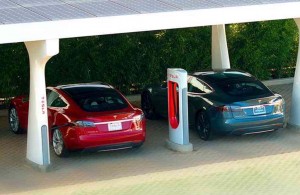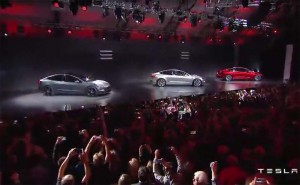When the new Tesla Model 3 goes on sale later next year, buyers will spend barely half as much for the 200-mile battery-car as the company currently charges for its original Model S sedan – but they could be in for some hefty, additional fees, especially if they also want to use Tesla’s Supercharger system.
That’s a network of high-speed chargers that let a motorist get up to an 80% “re-fill” in 30 minutes or less, depending upon the capacity of the battery. Use of the Supercharger system is free for life for owners of the Model S and newer Model X.
“Free supercharging fundamentally has a cost. The obvious thing to do is decouple that from the cost of the Model 3,” Musk said during Tesla’s annual shareholders meeting. “It will not be free long distance for life unless you purchase that package.”
How much Tesla plans to charge is unclear, but the South African-born entrepreneur suggested “it will still be very cheap, and for cheaper than gasoline, to drive long-distance with the Model 3.”
The Supercharger system was designed not only to give Tesla owners a way to recharge fast, but to make it possible to drive long distances without interminable delays along the way, a headache considered one of the reasons why battery-car sales have lagged early expectations.
But anecdotal reports have suggested that even with the relatively low volume of current Tesla sales – about 50,000 in 2015 – the Supercharger network is already reaching the limits of its capacity in some key locations, such as the route between Los Angeles and San Francisco.
The system could be stretched to the breaking point once the Model 3 comes to market and starts ramping up production. By 2018, Musk has set a goal of bringing total Tesla volume to 500,000 annually.
While Musk and other senior Tesla executives addressed various questions and concerns during the lengthy stockholders meeting, they steered the conversation off in a different direction, focusing more on the history of Tesla.
Among the personal anecdotes were tales of the many early mistakes Musk and company made. He admitted the team, including co-founder and Chief Technology Officer JB Straubel often had “no idea what we were doing,” and were “completely clueless.”
(Click Here to see why Tesla is looking to raise $2 billion with a new stock offering.)
Initially, Musk figured he would have to come up with virtually all the necessary financing because he was afraid of losing friends’ and investors’ capital.
The corporate environment, Musk added, encouraged saying “the things that we believe, even when sometimes those things are delusional.”
There were plenty of technical problems, as well, early on, especially when it came time to build the company’s first car, the original Tesla Roadster. Part of the propulsion system was digital, other parts analog, requiring extensive software rewrites. And there were mechanical issues, such as cooling and a multi-gear transmission that never seemed to work right.
And when Google founders Larry Page and Sergei Brin came for a test drive, Musk recalled, a Roadster prototype wouldn’t go faster than 10 mph. Even so, the pair did invest a little money in the start-up.
(UAW may try to organize Tesla factory in California. Click Here for more.)
Of course, critics would say those problems continue. Tesla has been slammed hard in recent months for quality and reliability problems that, among other things, led influential Consumer Reports magazine to pull its coveted “Recommended Buy” rating for the Model S.
Musk has promised to fix that problem in time for the Model 3 launch. A whole new management team has been brought in to revamp the company’s manufacturing system.
Whether the decision to charge for access to the Supercharger network is another clueless move remains to be seen, but Tesla’s real test will come next year with the launch of the Model 3. The company is still solidly in the red and will soon launch another stock offering to help finish funding the car’s development. Only by meeting Musk’s admittedly ambitious sales goals can Tesla go mainstream and, if its business plan is no longer delusional, finally start earning a profit.
(Tesla among brands most bedeviled by software glitches, reports JD Power. Click Here for the story.)



